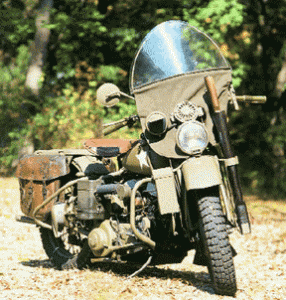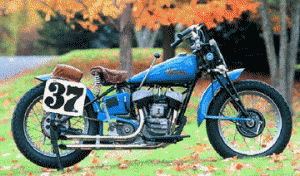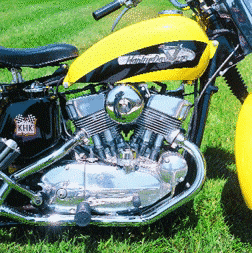By Jerry Hatfield
[The History of Flathead American Motorcycles was originally published in American Rider magazine]
Most lawnmower factories still build the lowest-cost engines they can. American car and motorcycle factories did likewise from the early teens into the 1950s. The little engine that putt-putts over your lawn is probably like those that powered Harley-Davidsons and Indians during the 1930s, the critical years of the Great Depression. But there was more to the 1930s American motorcycle plot than simple economics.
Before 1915, engineers saw the promise of overhead-valve and overhead-cam engines. But the theoretical idea was well ahead of the practical. The problem was the unsettled state of metallurgy, and this made exhaust valves a nagging worry in high-output overhead-valve engines. Melted exhaust valves were such a threat that in the teens and 1920s Harley factory racing teams entered both overhead-valve and F-head bikes.
F-head engines were a compromise between flatheads and overheads, in that each cylinder was fitted with an overhead intake valve and an upside-down exhaust valve. The two valves were off to the side of the cylinder bore in a “pocket” that gave rise to the term pocket-valve motor. In F-head engines, the intake charge passed over the exhaust valve. This cooled the exhaust valve, but diluted the intake charge and reduced maximum power.
The Harley team used their overhead-valve racers to set a blistering pace that generally melted the Indian and Excelsior engines. The F-head Harleys were in the lineup to soldier away in the back of the pack and wait for all the Harley and non-Harley overheads to pack up. The strategy, pioneered by Harley-Davidson’s original engineer Bill Harley, enabled the company to dominate American long-distance racing, which gave stock Harleys the go-fast image in the “street wars.”
Indian had been building side-valve, or flathead, road models since 1920, but had never fielded them in American racing. In 1926, Indian startled everybody with flathead racers that won on the Rockingham, New Hampshire, 1-1/4-mile board track. The winning Indian flathead averaged 114 mph, a pace previously beyond the reach of all but the very best factory overheads.
The Indian flatheads remained the pace-setters during 1927 and 1928. Harley-Davidson began planning to replace its F-head V-twin roadsters with flathead roadsters largely on the strength of Indian’s flathead racing success in the late 1920s.

The big three American motorcycle companies, Harley-Davidson, Indian, and Excelsior, had ignored overhead-valve engines for roadsters because of the twin concerns of exhaust-valve reliability and the problem of oil leakage. The latter was caused by the exposed rocker arms, valve stems, and valve springs, such exposure being necessary at the time in order to cool the fragile exhaust valves.
The signature advantage of overhead-valve engines was their greater torque and horsepower. But this power advantage was mitigated by the poor fuels of the era. It should have been possible to run overheads with 8:1 or 9:1 compression ratios, but low-octane gasoline limited compression ratios to about 7:1. In road-going motorcycles, accepting an oil-covered engine in order to capture slightly more power just wasn’t a good tradeoff.
Harley-Davidson stuck with F-head V-twins longer than any other company. Across the Atlantic, F-heads had given way to flatheads by 1920, and by 1925 flatheads were joined by overheads in trans-Atlantic manufacturers’ lineups. In the middle of the Indian flathead racing revolution and Harley’s re-think of their roadster lineup, came the production of tetraethyl lead as a fuel additive. Leaded gasoline permitted higher compression ratios than had been possible on earlier lower octane fuels. Thus the stage was set for the ultimate dominance of overhead-valve engines. But in the meantime, those pesky flatheads were going to have their moment in motorcycling history.
The logic of overhead-valve and F-head engines was simple and easy to appreciate, but the side-valve concept was counter-intuitive. If the valves were “upside-down” and offset from the bore, it would seem that the inlet and exhaust valves belonged on opposite sides of the cylinder. There were a few such “T-head” engines in the automotive field, but T-head motorcycles had long since gone extinct due to insufficient power.
Flathead engines presented a ridiculous flow pattern. Consider a Harley-Davidson flathead 45-degree V-twin. The inlet charge flows through the horizontal manifold, makes a 90-degree turn toward a cylinder, flows 45 degrees upwards, and makes another 90-degree turn as it passes through the inlet port. The inlet charge dissipates as some of the mixture swims to the side of the valve opposite the bore, then the fuel/air mixture rushes horizontally across the bridge between the valve chamber and the bore, and turns 90 degrees downwards into the bore.
As the piston moves upward on the compression stroke, the compression effect is diluted because the valve side of the combustion chamber is also pressurized off to the side of the bore. On the exhaust cycle, the hot exhaust flows right next to the inlet port, and in the opposite direction from the next inlet charge. One wonders how valve overlap worked at all!

For all the counter-intuitiveness, flathead engines shined where it mattered, both on the roads and on the race tracks. The fabled “squish” principle was at work in the successful flatheads. According to English motorcycle historian Peter Hartley, one of the earliest experimenters with flow dynamics was Irish racer Charles Franklin who in 1911 had accidentally discovered the squish principle after welding a lump of metal in the roof of an Indian F-head racer. Franklin’s racer thus had a combustion chamber with a roof that sloped downward as it proceeded from the valve pocket to and across the cylinder bore. This sloped roof idea was later patented by Englishman Harry Ricardo, resulting in the term “Ricardo heads.” Charles Franklin’s experiments were vital to American motorcycle development, because in 1916 Franklin moved to the United States to become chief engineer for the Indian motorcycle factory.
In the late 1920s, as Harley-Davidson assessed its engineering future, factory engineers looked at evidence drawn from warranty claims and dealers’ reports. The records indicated that their F-head V-twins weren’t going to be sufficiently reliable in the future because of improved roads and consequently faster average speeds.
On the Harley F-head twins, the exposed rocker arms and valve stems were covering the engines with oil film, which made riding a messy experience. Equally troublesome was the excessive wear brought on by the dust of mostly unpaved roads; this dust mixed with the oil mist to form an effective grinding compound. Though Harley-Davidson knew that someday overhead-valve engines would rule, the company needed new models, and the company needed them now.
In contemporary overheads, the exhaust valves still needed exposure to the air stream. This signaled that the mess and wear of the F-heads would simply be doubled when all the valves were on top and exposed. Harley engineers were staring at Indian success, so Chief Engineer William S. Harley swallowed his pride and decided that the 1930 Harley-Davidson Big Twins would be flatheads. The 1930 Harley flathead Big Twins were about a hundred pounds heavier as a result of more robust construction including bigger brakes and heavier frames. As a result, acceleration wasn’t as good as the top-of-the-line F-head sport models.

But the increased reliability of the new flatheads was quickly apparent. Astute dealers like Tom Sifton of San Jose, California, organized frequent fast road runs that showcased the staying power of the new flatheads and the relative fragility of the old F-heads.
However, the ever improving road situation and the ever higher road speeds soon began to make clear that, like the F-heads, the Harley flatheads weren’t going to stand up to the abuse of the faster riders. Factory records revealed that piston failures were all too common in their 1200cc Seventy-four (signifying 74 cubic inches).
Indian no doubt was also struggling to keep their 1200cc flathead Chiefs reliable. The piston failures were a result of the horrible heat distribution in flathead engines. As always, the exhaust valve was the troublemaker. The hot exhaust valve and exhaust port, being off to the side of the bore, and also next to the cooler inlet valve and port, resulted in significant cylinder warping. Warped cylinders in turn spelled reduced ring contact and power loss. Lost power meant that some fuel energy was being wasted in the form of extra heat. So warping reduced power, which increased heat which increased warping—the classic vicious cycle.
After only three years of experience with the Harley-Davidson flathead Big Twins, in 1933 the factory began designing an overhead-valve big twin, the 1,000cc Model 61 OHV (61 cubic inches), later to be called the Knucklehead. The revolutionary model was launched during the spring of 1936. This, after the Panhead and Shovelhead variations, would eventually become the Evolution engine that we are so familiar with. But Indian was so cash poor they never converted the Chief to overhead-valve configuration.
Though Harley-Davidson switched to overhead valves on their Big Twins, Harley as well as Indian continued to build road-model flathead 750cc/45-cubic-inchers through 1941. During World War II, Harley built over 60,000 military flathead 45s, mostly for American forces. Indian built about half as many 45-inch flatheads, almost all of these going to American allies. After the war, Indian made only one flathead model, the Big Chief. By 1949, all Harley Big Twins featured overhead valves, but the Milwaukee factory continued to turn out flathead middleweights through 1956. Remarkable, considering that American car manufacturers had long switched to OHV powerplants.
As from 1933 through 1941, post World War II American racing featured a mixed-bag rule that pitted American 750cc flatheads against British 500cc overheads. This Class C racing for stock bikes was born at the low point of the Great Depression. The formula was designed to keep cash-strapped Harley-Davidson and Indian out of the racing-development business, as flatheads were deemed hopelessly unfit for further racing development.
In the early 1930s, the mixed-bag rule produced parity between the American V-twin racers and a trivial number of British overhead-valve singles, most of the latter owned by Canadian riders.
However noble the mixed-bag rule might have been at the outset, politics became ever more a factor during the 1950s when parity (or Harley dominance, take your pick) was achieved by compression-ratio limits that effectively punished only overhead-valve racers from across the pond. Only in America could flathead racing be conducted with a straight face. Ours was a land of cheap overhead-valve Chevrolets and expensive flathead Cadillacs. In the four-wheeled street wars, flathead Fords were the go-fast choice rather than overhead-valve Chevrolets. Go figure.
The ultimate expression of flathead motorcycle racing came in 1969, the first year of a 750cc formula regardless of engine configuration. The rule change caught Harley-Davidson without a new overhead-valve racer, so 1969 was the last year of factory support for the flatheads.
The incomparable Cal Rayborn won his second consecutive Daytona 200 on a Harley-Davidson KRTT. On the 1.125-mile dirt track at Nazareth, Pennsylvania, Fred Nix on a Harley KR twin won the 50-lap national championship race. Both riders defeated British 650cc overhead twins and 750cc overhead triples. The season’s top points earner was Mert Lawwill, who campaigned on Harley flatheads.
After the demise of Indian in 1953, the Harley factory was the world’s only sponsor of flathead motorcycle racing. From 1954 through 1969, Harley-Davidsons won 59 percent of American national championship races. Based on seasonal points totals, Harley riders were 13 of the 16 Grand National Champions. Excepting 1969, these championships were in part the politics of the mixed-bag rule.
In the early 1970s, Harley-Davidson became even more dominant in the strictly overhead-valve racing than they had been in mixed-bag racing. To this writer, this validates the incredible job the Harley factory had done in making their flatheads race worthy.
The last flathead American bikes were three-wheeled Harley-Davidson Servi Cars, most of which were used by police officers to issue parking tickets. These were last cataloged as 1973 models, but a few were built in 1974.
From 1920 through 1969, flathead Indians and Harleys were a major force in American motorcycling. That’s quite a history for a genre that barely found its moment in time.







